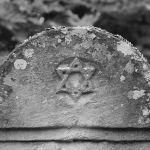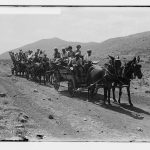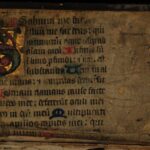Tracing Jewish Roots: A Journey through Time
The Origins of Jewish Genealogy
Genealogy, the study of family lineages and ancestry, has been an integral part of Jewish tradition for millennia. The roots of Jewish genealogy can be traced back to ancient times, where the preservation of family histories played a crucial role in both religious and cultural contexts.
The importance of lineage is deeply ingrained in Jewish culture, and it finds its origins in the Hebrew Bible, also known as the Torah. The Torah contains numerous genealogies, tracing the ancestry of significant figures and families, establishing connections to the past, and reinforcing the notion of continuity from one generation to the next.
Ancient Records and Lineage Tracing
One of the earliest instances of genealogy within the Jewish context can be found in the Book of Genesis, where genealogies of patriarchs like Adam, Noah, and Abraham are documented. These ancient records not only served religious purposes but also provided an essential framework for inheritance, land ownership, and social structure within Jewish communities.
As Jewish communities grew and thrived in various regions, they developed local record-keeping practices, documenting vital events such as births, marriages, and deaths. These records were often maintained by religious authorities, such as rabbis, and were recorded in Hebrew or other regional languages. Some ancient Jewish communities, like the Sephardic Jews in Spain, Portugal, and North Africa, left behind rich documentation of their lineage and migration patterns, which has proved invaluable for contemporary genealogical research.
Challenges and Uniqueness of Jewish Ancestral Research
While Jewish genealogy offers a fascinating journey into the past, it also comes with its own set of challenges. The history of the Jewish people is marked by dispersion and migration, often driven by exiles, forced conversions, and persecutions. These historical events have scattered Jewish communities across the globe, making the search for ancestors more complex and intriguing.
One of the primary difficulties faced by Jewish genealogists is the lack of consistent surnames in historical records. Traditionally, Jewish individuals were identified by their given names, often followed by their father’s name (patronymic) or their ancestral town (geographic identifier). This practice resulted in a wide range of surname variations for a single family, making it challenging to track lineages accurately.
Another unique aspect of Jewish genealogy is the preservation of family stories and oral histories. With a strong emphasis on storytelling, much of Jewish heritage has been passed down through generations through narratives, anecdotes, and memories. While written records are vital, combining them with oral history can provide a more holistic and intimate understanding of family connections and traditions.
Moreover, the tragic events of the Holocaust during World War II further complicate Jewish genealogy. The destruction of entire communities and vital records during this dark period has made it exceptionally difficult to trace the ancestry of Holocaust survivors and victims.
Despite these challenges, advancements in technology, the digitization of historical records, and the growing interest in genealogy have opened up new avenues for exploring Jewish roots. DNA testing, online archives, and collaborative genealogical platforms now offer researchers unique tools to connect with distant relatives, reconstruct lost family branches, and rediscover the diverse tapestry of Jewish heritage.
Diaspora and Migration: Unraveling the Global Jewish Family
Jewish Migration Patterns and Settlements
The history of the Jewish people is intricately tied to the concept of diaspora and migration. From ancient times to the present day, Jews have dispersed far and wide, settling in diverse regions across the world. These migratory patterns have not only shaped the global Jewish family but have also left a profound genealogical impact.
The first significant Jewish diaspora occurred in 586 BCE when the Babylonians conquered the Kingdom of Judah, leading to the exile of a large number of Jews to Babylon. This event marked the beginning of a recurrent theme in Jewish history—the dispersion and resettlement of Jewish communities due to various factors, including conquests, persecutions, and economic opportunities.
Over the centuries, Jewish communities established settlements in regions as varied as Europe, North Africa, the Middle East, Asia, and the Americas. Each migration brought with it unique cultural and religious practices that merged with local traditions, creating a rich tapestry of Jewish heritage around the world.
Genealogical Significance of Major Diaspora Events
Major diaspora events have significant genealogical significance as they often led to the fragmentation and scattering of family units across vast distances. Jewish families were separated from their ancestral homelands, leaving behind records and connections that were not always easy to retrace. However, these very challenges have inspired many genealogists to embark on extraordinary journeys of discovery, piecing together fragments of history and reconnecting long-lost branches of the global Jewish family tree.
For instance, the Spanish and Portuguese Inquisitions during the 15th and 16th centuries led to the expulsion of Sephardic Jews from the Iberian Peninsula. Many fled to neighboring countries in Europe, North Africa, and the Ottoman Empire, while others sought refuge in the New World. The Sephardic diaspora has since left an indelible mark on Jewish genealogy, with numerous descendants keen to rediscover their ancestral origins and Sephardic heritage.
Similarly, the Jewish migration to the United States in the late 19th and early 20th centuries brought together Jews from diverse European backgrounds. As they settled in urban centers like New York City, Chicago, and Boston, they formed tight-knit communities, preserving distinct family traditions and customs. Unraveling the stories of these immigrant families has become a passionate pursuit for many genealogists seeking to understand their own heritage and connect with their immigrant ancestors’ experiences.
Exploring Jewish Ancestry across Continents
One of the most exciting aspects of Jewish genealogy is the opportunity to explore and trace ancestry across continents. The Jewish people have a rich and diverse cultural heritage, influenced by the regions and countries they have inhabited.
For example, Ashkenazi Jews, who originated in Central and Eastern Europe, have a distinct genealogy, with surnames often reflecting their geographic origins. Learning about the historical context of these communities can help researchers understand migration patterns and family connections across different regions.
On the other hand, the Sephardic Jews, who descended from the Iberian Peninsula, have their own unique genealogical paths, spread across countries such as Turkey, Greece, Morocco, and the Balkans. Exploring Sephardic ancestry can reveal intriguing historical narratives of migration and interaction with various cultures throughout the Mediterranean.
Additionally, Mizrahi Jews, hailing from the Middle East and North Africa, possess a rich genealogical history, with lineages that stretch back centuries and connect to ancient Jewish communities in places like Iraq, Iran, Egypt, and Yemen.
Sephardic and Ashkenazi Genealogy: Uniting Diverse Traditions
Understanding Sephardic and Ashkenazi Jewish Lineages
Jewish genealogy is as diverse as the Jewish people themselves, and two prominent branches that have profoundly impacted the Jewish world are Sephardic and Ashkenazi communities. Understanding the lineages and histories of these two groups reveals a captivating tapestry of traditions that have traversed time and geography.
Sephardic Jews trace their origins to the Iberian Peninsula, primarily Spain and Portugal. “Sephardic” is derived from the Hebrew word for Spain, “Sepharad.” In the Middle Ages, they flourished in the region, contributing to the vibrant cultural and intellectual life during the Golden Age of Spain. However, the Sephardic community faced persecution during the Spanish Inquisition and subsequently dispersed to various parts of the world, including North Africa, the Ottoman Empire, the Balkans, and the Middle East.
On the other hand, Ashkenazi Jews originate from Central and Eastern Europe, primarily Germany and neighboring regions. The term “Ashkenazi” comes from the Hebrew word for Germany, “Ashkenaz.” The Ashkenazi community thrived in Eastern Europe and developed its own unique traditions, including distinctive language (Yiddish) and religious customs.
Genealogical Differences and Overlapping Histories
Sephardic and Ashkenazi Jewish genealogy presents both challenges and opportunities for researchers. The differences in historical migration paths, naming conventions, and cultural practices create distinct genealogical trails that require unique research approaches.
Sephardic Jews, for instance, often adopted Spanish and Portuguese surnames before their dispersion. Tracing these surnames can lead to fascinating discoveries of Sephardic heritage and the migration routes of families across continents. Moreover, the Sephardic tradition of matrilineal surnames, where surnames are passed down through the mother’s line, adds an intriguing layer to genealogical exploration.
In contrast, Ashkenazi Jewish genealogy typically follows the Eastern European naming pattern, with surnames derived from ancestral town names, occupations, or personal characteristics. Despite the challenges posed by changing borders and shifting political landscapes in Eastern Europe, the Ashkenazi Jewish diaspora has left a rich paper trail of records, including vital records, censuses, and synagogue documents.
Interestingly, despite their separate histories, Sephardic and Ashkenazi Jewish genealogies occasionally intersect, leading to unique family connections and blended traditions. Intermarriages between the two communities over the centuries have created diverse lineages that highlight the interconnectedness of the Jewish people.
Preserving and Documenting Distinctive Jewish Heritage
Preserving the distinctive heritage of Sephardic and Ashkenazi Jews is of paramount importance in the field of Jewish genealogy. The stories, customs, and family histories of these communities contribute to the rich tapestry of Jewish culture and identity.
For Sephardic genealogy, preservation efforts often focus on documenting oral histories and family traditions. The Sephardic diaspora spread across the Mediterranean, North Africa, the Middle East, and beyond, leading to a fascinating amalgamation of cultural practices. Collecting and recording these unique customs is essential to safeguarding the Sephardic legacy for future generations.
In the case of Ashkenazi genealogy, the preservation of Yiddish language and Jewish traditions in Eastern Europe has become a central focus. Projects that digitize and transcribe Yiddish-language documents, gravestones, and historical records ensure that the Ashkenazi heritage endures and is accessible to a global audience.
Collaborative efforts between genealogists, historians, and Jewish communities worldwide play a vital role in preserving the stories and lineage of both Sephardic and Ashkenazi Jews. Online databases, family history websites, and genealogical societies facilitate the sharing of research, enabling individuals to connect with their roots and celebrate the diverse traditions that enrich Jewish heritage.
Holocaust Survivor Stories: Resilience and Family Reconnections
Tracing Ancestry of Holocaust Survivors and Victims
The Holocaust stands as one of the darkest chapters in human history, inflicting immeasurable pain and tragedy on the Jewish people. During this unprecedented period of horror and destruction, millions of innocent lives were lost, and countless families were torn apart. Despite the devastating impact of the Holocaust on Jewish genealogy, the stories of survivors and their resilience in preserving their ancestry are a testament to the indomitable human spirit.
Tracing the ancestry of Holocaust survivors and victims is often a daunting task due to the destruction of vital records during the war. The Nazis deliberately sought to eradicate any evidence of Jewish existence, making it challenging to find official documents and genealogical records. However, the determined efforts of researchers, archivists, and genealogists have managed to uncover fragments of information, testimonies, and survivor accounts, allowing descendants to piece together their family histories.
Testimonies of Family Reunifications after World War II
Despite the immense suffering and loss experienced during the Holocaust, the post-war era brought forth poignant stories of family reunifications. Many Holocaust survivors embarked on arduous journeys to find their loved ones, leaving no stone unturned in their pursuit of family connections. These stories of reunions are both heartwarming and bittersweet, representing a glimmer of hope amidst the darkness of the Holocaust’s aftermath.
Survivors who managed to rebuild their lives often faced significant obstacles, including displacement, the challenges of starting anew in foreign lands, and the psychological scars of their traumatic experiences. Yet, their determination to reconnect with family members and rebuild shattered bonds reveals the resilience of the human spirit and the profound importance of family ties.
The Impact of the Holocaust on Jewish Genealogical Research
The Holocaust has had a profound and lasting impact on Jewish genealogical research. The loss of millions of lives resulted in the disappearance of entire branches of families, leaving gaps and unanswered questions in genealogical records. Many Jewish communities were decimated, with synagogues, cemeteries, and communal archives destroyed.
Moreover, the forced migration of survivors and the uprooting of families from their ancestral homes disrupted the transmission of oral histories and family traditions. These challenges make the task of tracing family lineages more complex and emotionally charged for descendants seeking to understand their heritage and honor the memories of their ancestors.
Nevertheless, the pursuit of Jewish genealogy has gained renewed significance as a way to preserve the memory of Holocaust victims, honor survivors, and maintain a connection to the past. By documenting survivor testimonies, reconstructing family histories, and preserving the collective memory of Jewish communities that perished, genealogists and researchers play a vital role in ensuring that the Holocaust is never forgotten.
In the face of unimaginable tragedy, Holocaust survivor stories serve as a testament to human resilience, strength, and the enduring power of family bonds. The stories of those who survived, rebuilt their lives, and sought to reconnect with their families inspire us to remember the past, cherish our heritage, and continue the search for truth and understanding. By embracing these stories and delving into the complexities of Jewish genealogical research, we pay tribute to the lives lost and celebrate the courage and tenacity of those who emerged from the darkness with stories of hope, survival, and the enduring spirit of family.
Genealogy and Jewish Heritage: Synagogue Records and Rituals
Exploring Synagogue Archives and Records
Synagogues, the central places of worship and communal gathering for Jewish communities, hold a wealth of historical information that is invaluable to genealogical research. Over the centuries, these sacred spaces have served as repositories of communal memory, preserving the stories and records of Jewish families and their ancestors.
Synagogue archives often contain a treasure trove of documents, including birth, marriage, and death records, as well as membership lists, ketubot (Jewish marriage contracts), and bar and bat mitzvah records. These records can provide essential details about the lives of individuals and families, helping researchers trace their genealogical roots with greater precision.
One particularly significant aspect of synagogue records is the existence of yizkor books. Yizkor books, memorial books created by Jewish communities in memory of those who perished during the Holocaust, contain biographical information, photographs, and personal accounts of the individuals who were lost. These poignant volumes are not only a tribute to the deceased but also a valuable resource for descendants seeking to uncover family histories and stories.
Genealogical Clues within Jewish Rituals and Traditions
Jewish rituals and traditions offer unique genealogical clues that can shed light on family connections and historical roots. Some rituals, such as brit milah (ritual circumcision), naming ceremonies, and bar and bat mitzvahs, are joyous occasions that are often documented and celebrated within the community.
Moreover, Jewish naming conventions can provide significant genealogical insights. Traditionally, Jewish individuals are named after deceased relatives as a way of honoring their memory. This practice has resulted in patterns of naming within families, with specific names recurring across generations. By tracing these naming patterns, genealogists can identify familial relationships and connections.
Jewish tombstones also offer valuable genealogical information. Inscriptions on gravestones typically include the Hebrew name of the deceased, the names of their parents, and sometimes the names of their spouse and children. Epitaphs may also provide insights into the character, achievements, and familial relationships of the departed.
Utilizing Religious Documents for Ancestral Research
Religious documents play a crucial role in Jewish genealogical research. Ketubot, for instance, are not only beautiful pieces of art but also legal contracts that provide details about the bride and groom, their parents, and witnesses present at the wedding. These documents can help researchers trace marriage alliances and connections between families.
Additionally, synagogue registers and congregation minutes can offer valuable genealogical information. These records may contain details about new members joining the community, individuals taking on leadership roles, or financial contributions made by community members. Such records can provide a glimpse into the social fabric of the Jewish community and the interactions between families.
In recent times, the digitization of religious documents and archives has revolutionized Jewish genealogy. Online databases and collaborative platforms have made it easier for researchers to access and share records from various synagogues and Jewish communities around the world. This newfound accessibility has enabled individuals to bridge geographical barriers and uncover their Jewish heritage with greater ease and efficiency.
Modern Technology and Jewish Genealogy: DNA, Online Resources, and Beyond
In the digital age, modern technology has revolutionized the field of genealogy, opening up new avenues of exploration for individuals seeking to uncover their Jewish heritage. From DNA testing to vast online databases, these advancements have provided genealogists with powerful tools to connect with their ancestral roots and weave together the intricate tapestry of Jewish family history.
Advancements in DNA Testing for Jewish Ancestry
DNA testing has emerged as a game-changer in Jewish genealogy, offering insights into ancestral origins and connections that were previously inaccessible. With specialized DNA testing services catering to Jewish ancestry, individuals can discover their genetic links to specific Jewish populations such as Ashkenazi, Sephardic, or Mizrahi Jews.
One notable aspect of DNA testing is the ability to find relatives across the globe, even among those unaware of their Jewish heritage. Through shared DNA matches and family trees, genealogists can identify previously unknown cousins and reconstruct branches of the family tree that were lost or forgotten over time.
Digital Archives and Online Databases for Jewish Genealogy
The internet has become a treasure trove of resources for Jewish genealogists, with numerous digital archives and online databases dedicated to Jewish family history research. Websites like JewishGen as comprehensive repositories of Jewish genealogical data, housing records from communities around the world.
JewishGen’s databases include vital records, cemetery records, Holocaust-related documents, yizkor books, and much more. Researchers can search these databases and connect with other genealogists, making collaborative efforts to piece together their family histories.
Furthermore, online platforms like Ancestry and MyHeritage have extensive collections of historical records that encompass Jewish communities, enabling users to explore census records, immigration documents, and more.
Future Prospects for Jewish Family History Research
The future of Jewish family history research is both promising and exciting. As technology continues to evolve, genealogists can expect even more sophisticated tools and resources to aid their search for Jewish ancestry.
With ongoing advancements in DNA analysis, researchers may gain deeper insights into migration patterns and genetic connections within the Jewish diaspora. As more people from diverse backgrounds participate in DNA testing, the scope of Jewish genealogy will expand, creating a more comprehensive picture of Jewish heritage worldwide.
Additionally, artificial intelligence and machine learning algorithms may enhance the efficiency of record matching and family tree building, helping researchers overcome language barriers and deciphering handwritten historical documents more accurately.
In conclusion, modern technology has transformed Jewish genealogy, bringing together a fusion of DNA analysis, digital archives, and collaborative platforms that enrich the journey of exploring Jewish heritage. As technology continues to evolve, the future prospects for Jewish family history research hold the promise of revealing even more fascinating insights into the diverse and resilient history of Jewish families across the globe.
Image Source:
- Photo by Levi Meir Clancy: instant images





